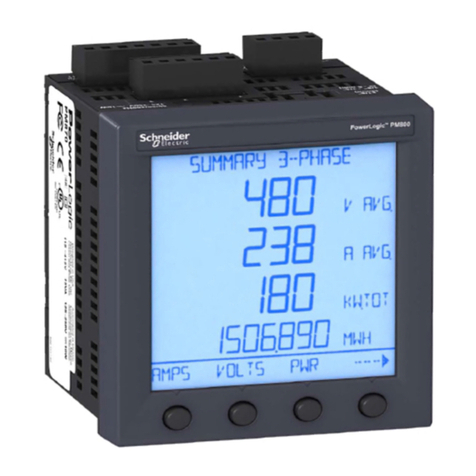
Power Meter Bulletin No. 3020IM9503R6/98
Contents December 1998
Chapter 7—Display Operation........................................................... 47
Introduction .................................................................................................... 47
Modes............................................................................................................. 47
Accessing a Mode ...................................................................................... 48
Setup Mode ................................................................................................ 49
Resets Mode............................................................................................... 50
Diagnostics Mode ....................................................................................... 50
Display Modes ............................................................................................ 50
How the Buttons Work ................................................................................ 51
Mode
Button............................................................................................ 51
Arrow Buttons.......................................................................................... 51
Select
Button........................................................................................... 51
Contrast Button ....................................................................................... 51
Setting Up the Power Meter ........................................................................... 52
Performing Resets ......................................................................................... 54
Viewing Diagnostic Information ...................................................................... 55
Using Display Modes ..................................................................................... 55
Setting Up Onboard Alarms (PM-650 only) .................................................... 55
ViewingActive Alarms (PM-650 only)............................................................. 56
Chapter 8—Metering Capabilities ..................................................... 57
Real-Time Readings....................................................................................... 57
Min/Max Values (PM-650 Only)...................................................................... 57
Power Factor Min/Max Conventions .............................................................. 58
Energy Readings............................................................................................ 61
Power Analysis Values ................................................................................... 62
Demand Readings (PM-620 and PM-650 Only) ............................................ 63
Demand Power Calculation Methods ......................................................... 63
Sliding Block Interval Demand ................................................................ 63
Block Interval Demand with Subinterval Option ...................................... 64
Synch to Comms..................................................................................... 64
Predicted Demand ...................................................................................... 64
Peak Demand ............................................................................................. 64
KYZ Pulse Output .......................................................................................... 65
Calculating the Pulse Constant .................................................................. 65
Chapter 9—Onboard Alarming (PM-650 Only) ................................. 66
Setpoint-Driven Alarms .................................................................................. 66
Setpoint-Controlled Relay Functions.............................................................. 67
Undervoltage .............................................................................................. 68
Unbalance Current ..................................................................................... 68
Unbalance Voltage ..................................................................................... 68
Chapter 10—Logging (PM-650 Only) ................................................ 69
Alarm Log ....................................................................................................... 69
Event Log ....................................................................................................... 69
Data Log......................................................................................................... 69
Alarm-Driven Data Log Entries ...................................................................... 69
Storage Considerations.................................................................................. 69




























